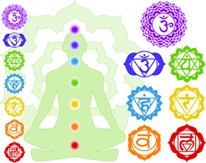What are Chakras?
 Inside every human being there is a network of nerves and sensory organs that interprets the outside physical world. At the same time, within us resides a subtle system of channels (nadis) and centers of energy (chakras) which look after our physical, intellectual, emotional and spiritual being.
Inside every human being there is a network of nerves and sensory organs that interprets the outside physical world. At the same time, within us resides a subtle system of channels (nadis) and centers of energy (chakras) which look after our physical, intellectual, emotional and spiritual being.
There are seven chakras, or energy centers, in the body that become blocked by longheld tension and low self-esteem. But practicing poses that correspond to each chakra can release these blocks. Together in a central column from the crown of your head to the base of your spine, when we open the centres and align them, we allow our vital energy (also known as Ki or Prana) to flow freely.
These centres can be instrumental in our physical, mental, emotional and spiritual energies – relating and working with them. The purpose of working with these energies is to integrate all aspects of your life to create a more holistic being.
The chakra system provides a theoretical base for fine-tuning our yoga practice to suit our unique personality and circumstances. Traditionally, Indians saw the body as containing seven main chakras, arranged vertically from the base of the spine to the top of the head. Chakra is the Sanskrit word for wheel, and these "wheels" were thought of as spinning vortexes of energy.
Each chakra is associated with particular functions within the body and with specific life issues and the way we handle them, both inside ourselves and in our interactions with the world. As centers of force, chakras can be thought of as sites where we receive, absorb, and distribute life energies. Through external situations and internal habits, such as long-held physical tension and limiting self-concepts, a chakra can become either deficient or excessive—and therefore imbalanced.
These imbalances may develop temporarily with situational challenges, or they may be chronic. A chronic imbalance can come from childhood experiences, past pain or stress, and internalized cultural values. For instance, a child whose family moves every year to a different state may not learn what it’s like to feel rooted in a location, and she can grow up with a deficient first chakra.
 A deficient chakra neither receives appropriate energy nor easily manifests that chakra’s energy in the world. There’s a sense of being physically and emotionally closed down in the area of a deficient chakra. Think of the slumped shoulders of someone who is depressed and lonely, their heart chakra receding into their chest. The deficient chakra needs to open.
A deficient chakra neither receives appropriate energy nor easily manifests that chakra’s energy in the world. There’s a sense of being physically and emotionally closed down in the area of a deficient chakra. Think of the slumped shoulders of someone who is depressed and lonely, their heart chakra receding into their chest. The deficient chakra needs to open.
When a chakra is excessive, it is too overloaded to operate in a healthy way and becomes a dominating force in a person’s life. Someone with an excessive fifth (throat) chakra, for example, might talk too much and be unable to listen well. If the chakra were deficient, she might experience restraint and difficulty when communicating.








